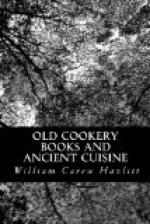The furnace pan for beef.
The beef kettle.
Great and small kettles.
Brass kettles, holding from sixteen to
twenty gallons each.
Little kettles with bowed or carved handles.
Copper pans with ears.
Great brass pots.
Dripping-pans.
An iron peel or baking shovel.
A brazen mortar and a pestle.
Gridirons.
Iron ladles.
A laten scummer.
A grater.
A pepper mill.
A mustard-quern.
Boards.
A salt-box.
An iron range.
Iron racks.
A tin pot.
Pot hooks.
A galley bawk to suspend the kettle or
pot over the fire.
Spits, square and round, and various sizes.
Bearers.
Crooks.
In the larders (wet and dry) and pastry were:—
Moulding boards for pastry.
A boulting tub for meal.
A little table.
A spice cupboard.
A chest for oatmeal.
A trough.
Hanging and other shelves.
Here follows the return of pewter, brass, and other vessels belonging to the kitchen:—
Pewter dishes of nine sizes (from Newcastle).
Long dishes for rabbits. }
Saucers. }
Chargers. } Silver fashioned.
Pie plates. }
Voider. }
A beef-prick.
Fire shoves and tongs.
A brig (a sort of brandreth).
A cullender.
A pewter baking-pan.
Kettles of brass.
A skillet.
A brandeth.
A shredding knife.
A chopping knife.
An apple cradle.
A pair of irons to make wafers with.
A brass pot-lid.
Beef-axes and knives. }
Slaughter ropes. } For Slaughtering.
Beef stangs. }
In the beef-house was an assortment of tubs, casks, and hogsheads. Table knives, forks, spoons, and drinking-vessels presumably belonged to another department.
The dripping-pan is noticed in Breton’s “Fantasticks,” 1626: “Dishes and trenchers are necessary servants, and they that have no meat may go scrape; a Spit and a Dripping-pan would do well, if well furnished.” Flecknoe, again, in his character of a “Miserable old Gentlewoman,” inserted among his “Enigmatical Characters,” 1658, speaks of her letting her prayer-book fall into the dripping-pan, and the dog and the cat quarrelling over it, and at last agreeing to pray on it!
But this is a branch of the subject I cannot afford further to penetrate. Yet I must say a word about the polished maple-wood bowl, or maser, with its mottoes and quaint devices, which figured on the side-board of the yeoman and the franklin, and which Chaucer must have often seen in their homes. Like everything else which becomes popular, it was copied in the precious metals, with costly and elaborate goldsmith’s work; but its interest for us is local, and does not lend itself to change of material and neighbourhood. The habits of the poor and




